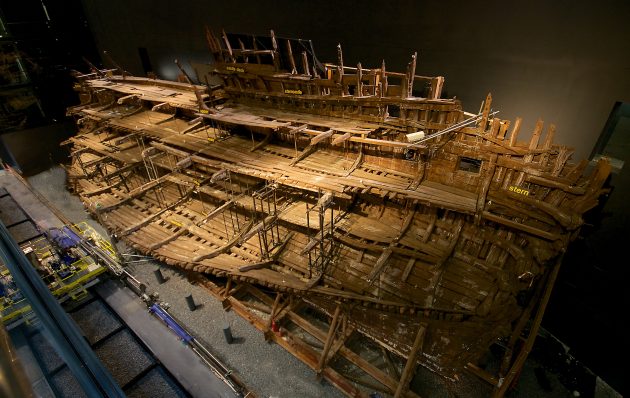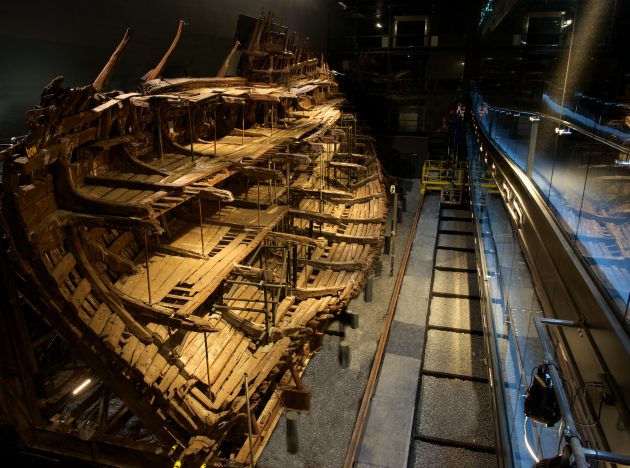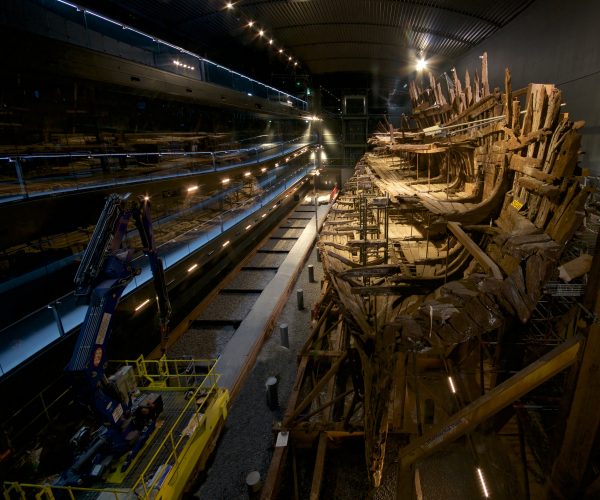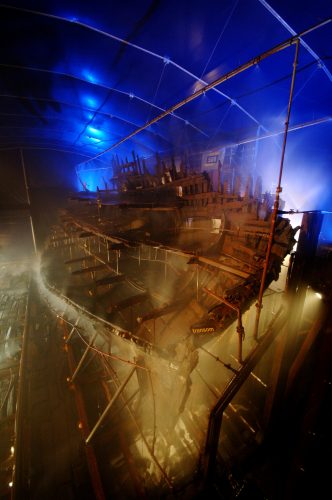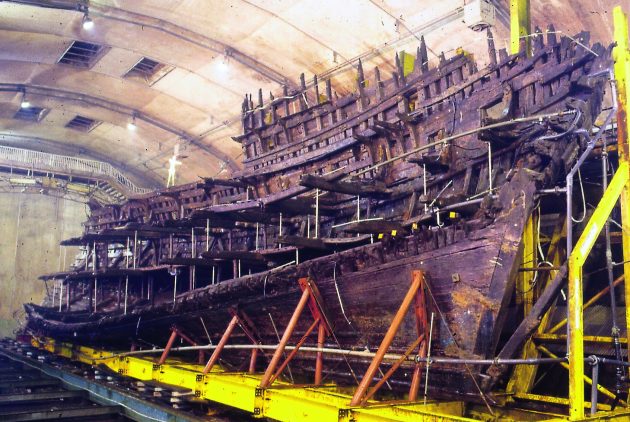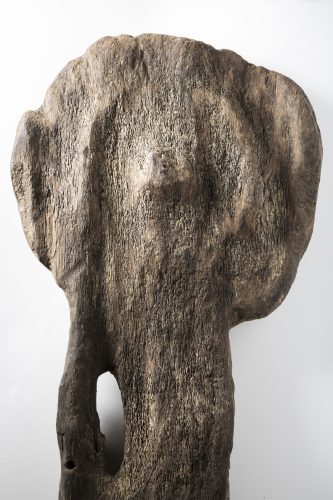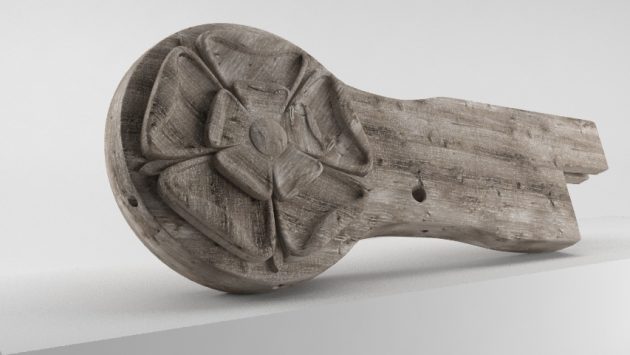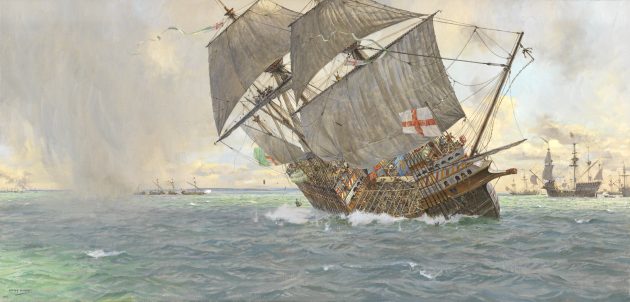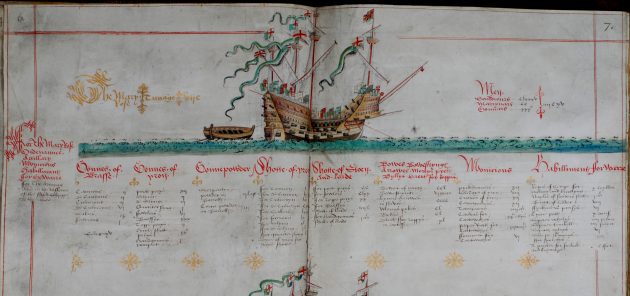For the first time since it was raised from the seabed, the Tudor flagship, Mary Rose will go on full display to the public. See pictures of the historic ship below.
From 20 July, the public will be able to see unobstructed views of Henry VIII’s most famous ship, the Mary Rose.
The Tudor warship has undergone constant restoration work for the last 34 years since it was raised from the Solent in 1982.
Following a £39 million investment, visitors to The Mary Rose Museum at Portsmouth Historic Dockyard will now be able to take in panoramic views of the ship.
Floor-to-ceiling glazing has been installed on the lower and main decks.
See pictures of the Mary Rose below
On the upper deck, visitors can enter the Weston Ship Hall via an airlock. Here, they will be separated from the ship by only a glass balcony.

The chief executive of The Mary Rose Trust, Helen Bonser-Wilton (right) and the trust’s head of conservation and collections care, Eleanor Schofield, looking at the famous warship in Portsmouth. Credit: Christopher Ison
An unique Tudor time capsule, the Mary Rose has been undergoing continuous conservation since the ship was raised.
The hull was first sprayed with a mist of fresh chilled water and then with a water-soluble wax from 1994 to April 2013 when the Mary Rose entered a stage of controlled air-drying.
The hull has now reached a stable state within this drying process, which means all the black drying ducts, which provided the environment and conditions around the ship, have been removed giving a completely clear and uninterrupted view.
The head of research and curator of ordnance at the Mary Rose Trust, Dr Alex Hildred, said: “When we excavated the Mary Rose we wanted people to see even a little of what we, as archaeologists, saw and experienced underwater.”
“The fact that you can see it from three different angles that you’ve never been able to see before except for when she first came up is brilliant. With the lights on her she begins to look like parts of the ship we saw underwater,” she said.

The raising of the Mary Rose in 1982. Credit: The Mary Rose Trust
The £39 million project has been backed by the Heritage Lottery Fund, which gave £26 million.
Its chair, Sir Peter Luff, said: “Quite simply, the Mary Rose is awe-inspiring. Over the years since her discovery and, in 1982, her subsequent raising from the sea bed to her display in this wonderful museum, each chapter of her life has intrigued and thrilled in equal measure.”
After decades of hard work, this final part of the conservation jigsaw brings the Mary Rose back into clear focus and spectacular context. To so many a huge debt of gratitude is owed; particularly to those whose vision, dedication and skill have made this vision a reality; and to the National Lottery players who enabled HLF to make grants of £26 million to this remarkable evocation of our national maritime heritage,” said Sir Peter.
The story of The Mary Rose in numbers
• 1510 – the year the Mary Rose was built.
• 600 trees were used to build the warship.
• 1545 – the year the Mary Rose sunk, on the 19 July during the 3rd French War.
• 500 men on board, only 35 survived.
• 5 foot 7 inches was the average height of a crew member.
• The Mary Rose sank to the bottom of the Solent lying on the seabed at a 60° angle.
• 1971 – the year the Mary Rose site was discovered and excavation begun.
• 27,831 dives made to the Mary Rose during the modern excavation project.
• 22,710 hours of marine archeological excavation of the seabed.
• 437 years the Mary Rose spent underwater.
• 1982 – the year the Mary Rose was raised from the seabed.
• 60 million people worldwide watched this event.
• 19,000 artefacts have been recovered from the site so far including:
• 6,600 arrow bits.
• 9 barrels containing bones of fully-grown cattle
• 1 full skeleton of a dog aged between 18 months and 2 years old. He goes by the name of Hatch.
• 100 tons of water extracted from the Hull and its environment over the last 3 years
• The Mary Rose has received 9 million visitors since she was first displayed in 1983
• 2016 – the year the Mary Rose Museum reopens to reveal the Tudor ship to the world, visitors will be able to view the ship from all 9 galleries in the museum.
Pictures: Centenary of the ‘largest naval battle in history’
The 31 May marks 100 years since the start of the Battle of Jutland. Artefacts from the First World War…
Researchers believe they’ve found Captain Cook’s Endeavour
The Rhode Island Marine Archaeology Project says it has now narrowed down the search for HMS Endeavour to a group…





